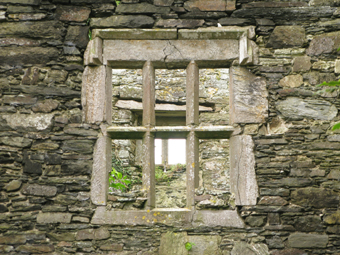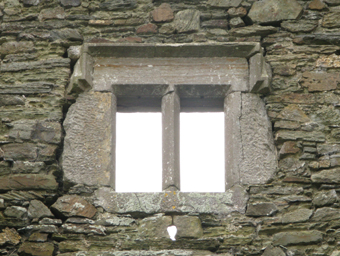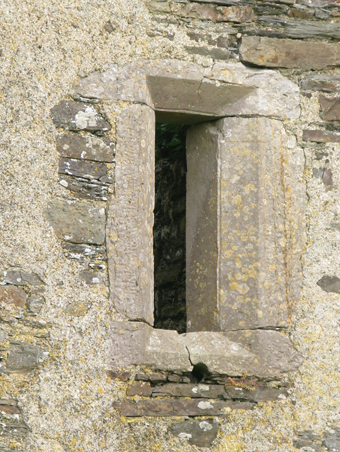Building of the Month - October 2017


| Set on high ground overlooking the winding Belgooly River and Oyster Haven, the ivy-covered Mountlong Castle makes a picturesque impression in the lush rural landscape, epitomising the romantic vista anticipated by the tourist visiting Ireland who expects to see an abundance of castles and to hear tales of ancient mythology.
Mountlong Castle, begun in 1631 by John Long, is a fine example of a new building type emerging in the early seventeenth century: the fortified house. An earlier type, the defensive towerhouse, dominated from the early 1400s until the 1640s. Seventeenth-century builders owed a debt to the numerous towerhouses scattered across the country and superimposed onto their basic form new architectural features introduced by English settlers. Mountlong Castle exemplifies the new style. Its proportions and detailing, including large mullioned windows, mark the transition from dimly-lit towerhouses with an overt defensive capability to properties boasting comfortable well-lit rooms and a modicum of fortification. One reason for being less preoccupied with defence was that this corner of Ireland was, for the most part, subdued by the English following the Munster Plantation. A new authority ruling the land, and less inter-tribal conflict between Gaelic lords, brought about a brief period of comparative political stability. In lieu of defence, builders could turn their attentions to aesthetics and functionality. |
Mountlong Castle boasts a flanker or tower on each of the four corners of the central tower. These are features shared in common with the contemporary Monkstown Castle (1636) and, originating in English architecture, may have been intended to supplement living accommodation. The mullioned windows, given chamfered frames and simple hood mouldings, were clearly not intended for defensive purposes. Nevertheless, gun loops covering most angles allowed a measure of protection against any potential enemies.


Another feature borrowed from English architecture was the gable-ended attic space and it quickly became the custom to use the “garrets” as accommodations for servants. Unlike the earlier towerhouses, where the household might share the same cramped quarters, the new houses saw the separation of the family and their servants into specially designated areas of the building. In accommodating the servants in quarters “out of sight”, houses such as Mountlong Castle set the precedent for the “upstairs downstairs” way of living that continued through the subsequent Georgian and Victorian periods.
In its ruined state it is difficult to decipher the exact function of the rooms on each of the three tiers of Mountlong Castle, however, it is reasonable to speculate that the ground floor was given over to the kitchens and ovens. The living accommodation overhead gives an insight into how much value was placed on aesthetics and, writing in 1907, J.F. Fuller describes cornices ‘with figures representing scriptural subjects and fieldsports’. No fireplaces survive in the main block but chimneys in the corner towers suggest that at least those rooms were well heated.
|
Unfortunately for its builder, the glory days of Mountlong Castle were brief. In 1641 a rebellion broke out in Ulster which quickly spread across the whole of Ireland. John sided with the Catholic rebels in a conflict that has since been known as a war between Catholic natives and Protestant settlers. John and his sons set up camp on top of a hill near Belgooly but the following April saw the defeat of the rebels near Bandon. It was the beginning of the end for the Long family and John was convicted of treason and hanged alongside many of his fellow rebels. Legend tells us that, aware that he would ultimately be captured and executed, John instructed a relative – some sources say his daughter and others his sister – to burn Mountlong Castle in order to prevent the Cromwellian army from using it for their own purposes. Remarkably, some timbers, including lintels over door and window openings, still carry scorch marks to this day! |
 |
Stephen Byrne obtained an honours degree in History and Spanish from NUI Maynooth in 2005. He completed a post-graduate in World Heritage Management in UCD in 2008 and a post-graduate in Building Repair and Conservation in Trinity College Dublin in 2009. Stephen is currently working in collections conservation with the National Trust. His area of special interest is seventeenth-century Irish architecture
Back to Building of the Month Archive